Community Nursing Practice- Assignment
VerifiedAdded on 2021/05/27
|12
|3242
|61
AI Summary
Contribute Materials
Your contribution can guide someone’s learning journey. Share your
documents today.
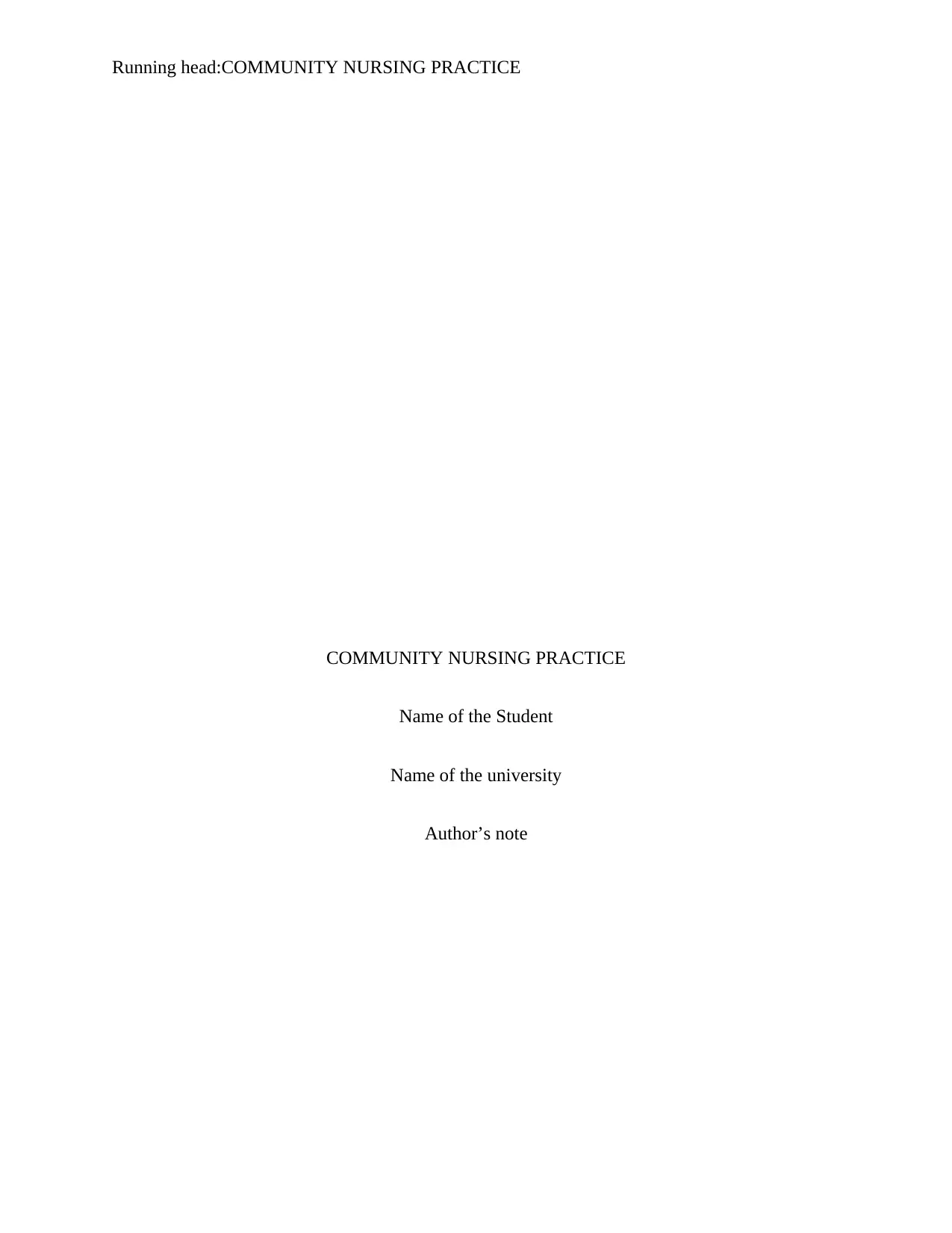
Running head:COMMUNITY NURSING PRACTICE
COMMUNITY NURSING PRACTICE
Name of the Student
Name of the university
Author’s note
COMMUNITY NURSING PRACTICE
Name of the Student
Name of the university
Author’s note
Secure Best Marks with AI Grader
Need help grading? Try our AI Grader for instant feedback on your assignments.
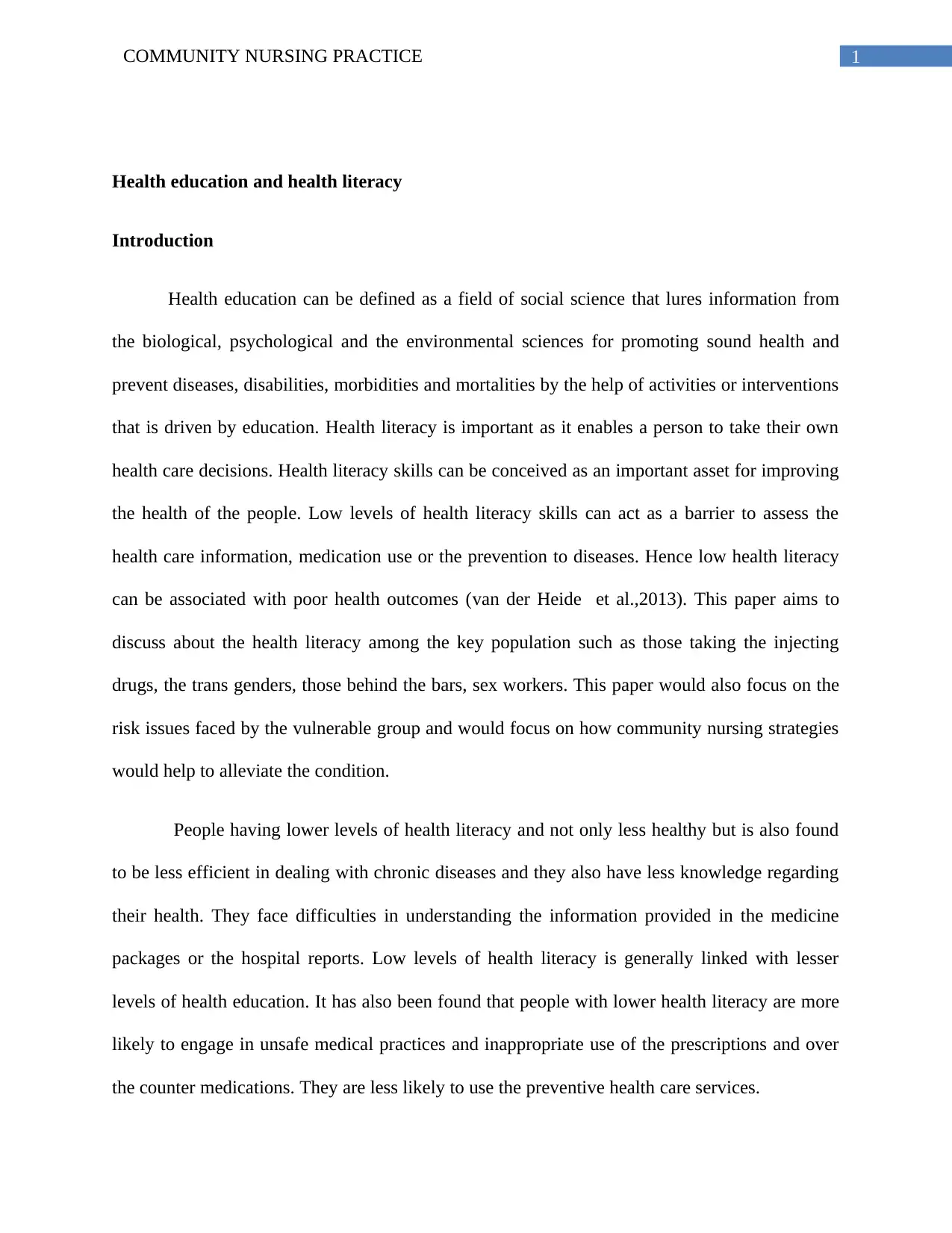
1COMMUNITY NURSING PRACTICE
Health education and health literacy
Introduction
Health education can be defined as a field of social science that lures information from
the biological, psychological and the environmental sciences for promoting sound health and
prevent diseases, disabilities, morbidities and mortalities by the help of activities or interventions
that is driven by education. Health literacy is important as it enables a person to take their own
health care decisions. Health literacy skills can be conceived as an important asset for improving
the health of the people. Low levels of health literacy skills can act as a barrier to assess the
health care information, medication use or the prevention to diseases. Hence low health literacy
can be associated with poor health outcomes (van der Heide et al.,2013). This paper aims to
discuss about the health literacy among the key population such as those taking the injecting
drugs, the trans genders, those behind the bars, sex workers. This paper would also focus on the
risk issues faced by the vulnerable group and would focus on how community nursing strategies
would help to alleviate the condition.
People having lower levels of health literacy and not only less healthy but is also found
to be less efficient in dealing with chronic diseases and they also have less knowledge regarding
their health. They face difficulties in understanding the information provided in the medicine
packages or the hospital reports. Low levels of health literacy is generally linked with lesser
levels of health education. It has also been found that people with lower health literacy are more
likely to engage in unsafe medical practices and inappropriate use of the prescriptions and over
the counter medications. They are less likely to use the preventive health care services.
Health education and health literacy
Introduction
Health education can be defined as a field of social science that lures information from
the biological, psychological and the environmental sciences for promoting sound health and
prevent diseases, disabilities, morbidities and mortalities by the help of activities or interventions
that is driven by education. Health literacy is important as it enables a person to take their own
health care decisions. Health literacy skills can be conceived as an important asset for improving
the health of the people. Low levels of health literacy skills can act as a barrier to assess the
health care information, medication use or the prevention to diseases. Hence low health literacy
can be associated with poor health outcomes (van der Heide et al.,2013). This paper aims to
discuss about the health literacy among the key population such as those taking the injecting
drugs, the trans genders, those behind the bars, sex workers. This paper would also focus on the
risk issues faced by the vulnerable group and would focus on how community nursing strategies
would help to alleviate the condition.
People having lower levels of health literacy and not only less healthy but is also found
to be less efficient in dealing with chronic diseases and they also have less knowledge regarding
their health. They face difficulties in understanding the information provided in the medicine
packages or the hospital reports. Low levels of health literacy is generally linked with lesser
levels of health education. It has also been found that people with lower health literacy are more
likely to engage in unsafe medical practices and inappropriate use of the prescriptions and over
the counter medications. They are less likely to use the preventive health care services.
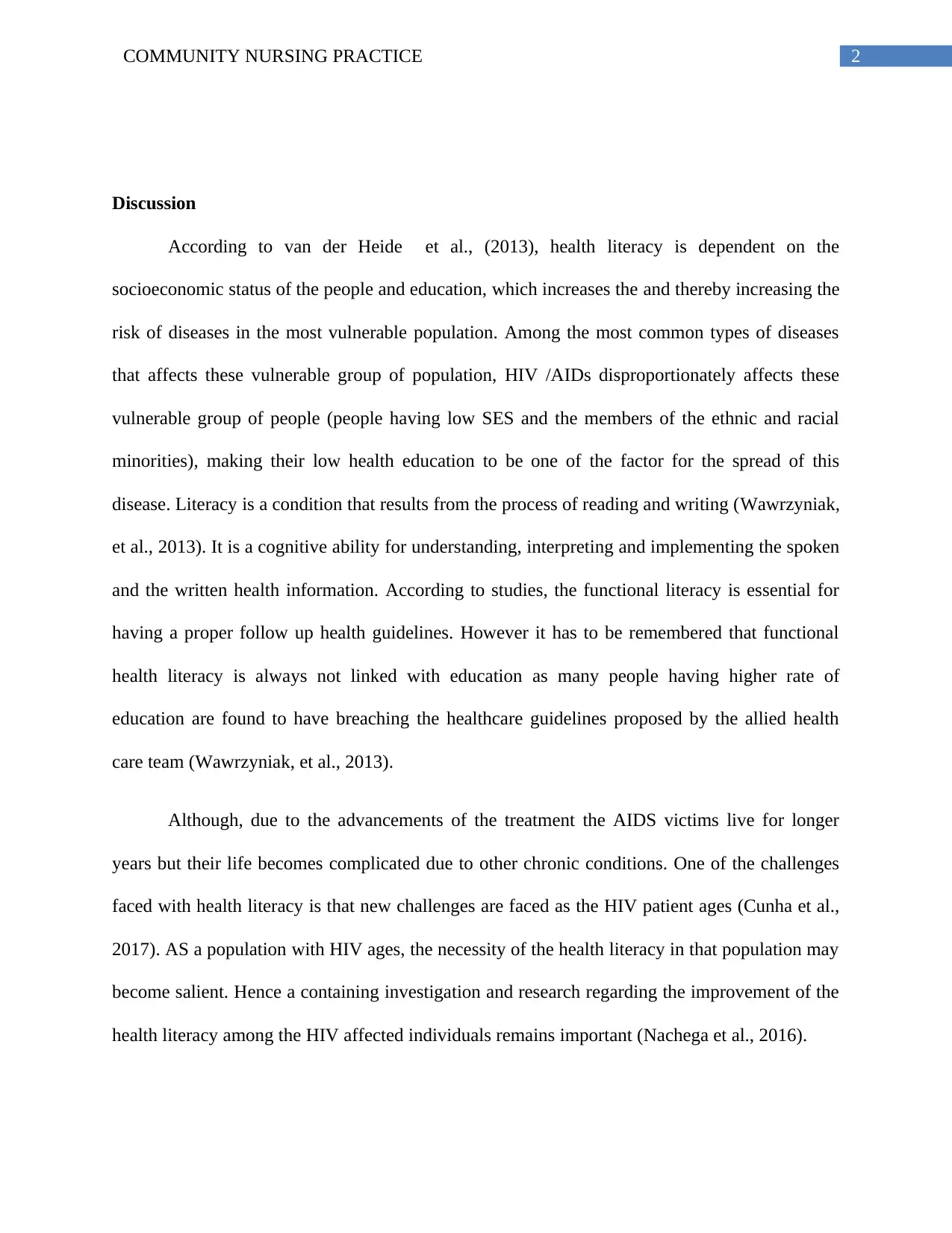
2COMMUNITY NURSING PRACTICE
Discussion
According to van der Heide et al., (2013), health literacy is dependent on the
socioeconomic status of the people and education, which increases the and thereby increasing the
risk of diseases in the most vulnerable population. Among the most common types of diseases
that affects these vulnerable group of population, HIV /AIDs disproportionately affects these
vulnerable group of people (people having low SES and the members of the ethnic and racial
minorities), making their low health education to be one of the factor for the spread of this
disease. Literacy is a condition that results from the process of reading and writing (Wawrzyniak,
et al., 2013). It is a cognitive ability for understanding, interpreting and implementing the spoken
and the written health information. According to studies, the functional literacy is essential for
having a proper follow up health guidelines. However it has to be remembered that functional
health literacy is always not linked with education as many people having higher rate of
education are found to have breaching the healthcare guidelines proposed by the allied health
care team (Wawrzyniak, et al., 2013).
Although, due to the advancements of the treatment the AIDS victims live for longer
years but their life becomes complicated due to other chronic conditions. One of the challenges
faced with health literacy is that new challenges are faced as the HIV patient ages (Cunha et al.,
2017). AS a population with HIV ages, the necessity of the health literacy in that population may
become salient. Hence a containing investigation and research regarding the improvement of the
health literacy among the HIV affected individuals remains important (Nachega et al., 2016).
Discussion
According to van der Heide et al., (2013), health literacy is dependent on the
socioeconomic status of the people and education, which increases the and thereby increasing the
risk of diseases in the most vulnerable population. Among the most common types of diseases
that affects these vulnerable group of population, HIV /AIDs disproportionately affects these
vulnerable group of people (people having low SES and the members of the ethnic and racial
minorities), making their low health education to be one of the factor for the spread of this
disease. Literacy is a condition that results from the process of reading and writing (Wawrzyniak,
et al., 2013). It is a cognitive ability for understanding, interpreting and implementing the spoken
and the written health information. According to studies, the functional literacy is essential for
having a proper follow up health guidelines. However it has to be remembered that functional
health literacy is always not linked with education as many people having higher rate of
education are found to have breaching the healthcare guidelines proposed by the allied health
care team (Wawrzyniak, et al., 2013).
Although, due to the advancements of the treatment the AIDS victims live for longer
years but their life becomes complicated due to other chronic conditions. One of the challenges
faced with health literacy is that new challenges are faced as the HIV patient ages (Cunha et al.,
2017). AS a population with HIV ages, the necessity of the health literacy in that population may
become salient. Hence a containing investigation and research regarding the improvement of the
health literacy among the HIV affected individuals remains important (Nachega et al., 2016).
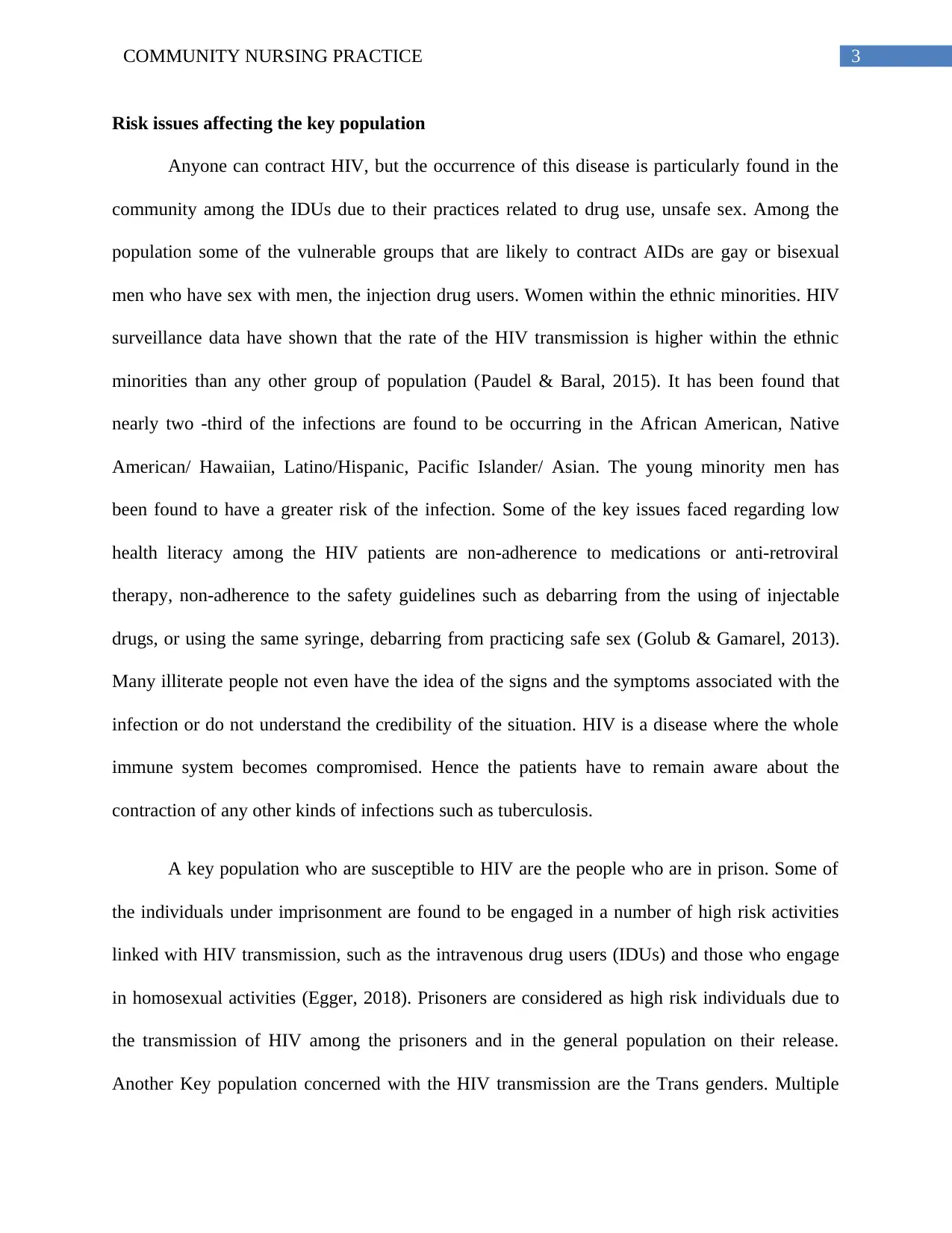
3COMMUNITY NURSING PRACTICE
Risk issues affecting the key population
Anyone can contract HIV, but the occurrence of this disease is particularly found in the
community among the IDUs due to their practices related to drug use, unsafe sex. Among the
population some of the vulnerable groups that are likely to contract AIDs are gay or bisexual
men who have sex with men, the injection drug users. Women within the ethnic minorities. HIV
surveillance data have shown that the rate of the HIV transmission is higher within the ethnic
minorities than any other group of population (Paudel & Baral, 2015). It has been found that
nearly two -third of the infections are found to be occurring in the African American, Native
American/ Hawaiian, Latino/Hispanic, Pacific Islander/ Asian. The young minority men has
been found to have a greater risk of the infection. Some of the key issues faced regarding low
health literacy among the HIV patients are non-adherence to medications or anti-retroviral
therapy, non-adherence to the safety guidelines such as debarring from the using of injectable
drugs, or using the same syringe, debarring from practicing safe sex (Golub & Gamarel, 2013).
Many illiterate people not even have the idea of the signs and the symptoms associated with the
infection or do not understand the credibility of the situation. HIV is a disease where the whole
immune system becomes compromised. Hence the patients have to remain aware about the
contraction of any other kinds of infections such as tuberculosis.
A key population who are susceptible to HIV are the people who are in prison. Some of
the individuals under imprisonment are found to be engaged in a number of high risk activities
linked with HIV transmission, such as the intravenous drug users (IDUs) and those who engage
in homosexual activities (Egger, 2018). Prisoners are considered as high risk individuals due to
the transmission of HIV among the prisoners and in the general population on their release.
Another Key population concerned with the HIV transmission are the Trans genders. Multiple
Risk issues affecting the key population
Anyone can contract HIV, but the occurrence of this disease is particularly found in the
community among the IDUs due to their practices related to drug use, unsafe sex. Among the
population some of the vulnerable groups that are likely to contract AIDs are gay or bisexual
men who have sex with men, the injection drug users. Women within the ethnic minorities. HIV
surveillance data have shown that the rate of the HIV transmission is higher within the ethnic
minorities than any other group of population (Paudel & Baral, 2015). It has been found that
nearly two -third of the infections are found to be occurring in the African American, Native
American/ Hawaiian, Latino/Hispanic, Pacific Islander/ Asian. The young minority men has
been found to have a greater risk of the infection. Some of the key issues faced regarding low
health literacy among the HIV patients are non-adherence to medications or anti-retroviral
therapy, non-adherence to the safety guidelines such as debarring from the using of injectable
drugs, or using the same syringe, debarring from practicing safe sex (Golub & Gamarel, 2013).
Many illiterate people not even have the idea of the signs and the symptoms associated with the
infection or do not understand the credibility of the situation. HIV is a disease where the whole
immune system becomes compromised. Hence the patients have to remain aware about the
contraction of any other kinds of infections such as tuberculosis.
A key population who are susceptible to HIV are the people who are in prison. Some of
the individuals under imprisonment are found to be engaged in a number of high risk activities
linked with HIV transmission, such as the intravenous drug users (IDUs) and those who engage
in homosexual activities (Egger, 2018). Prisoners are considered as high risk individuals due to
the transmission of HIV among the prisoners and in the general population on their release.
Another Key population concerned with the HIV transmission are the Trans genders. Multiple
Secure Best Marks with AI Grader
Need help grading? Try our AI Grader for instant feedback on your assignments.
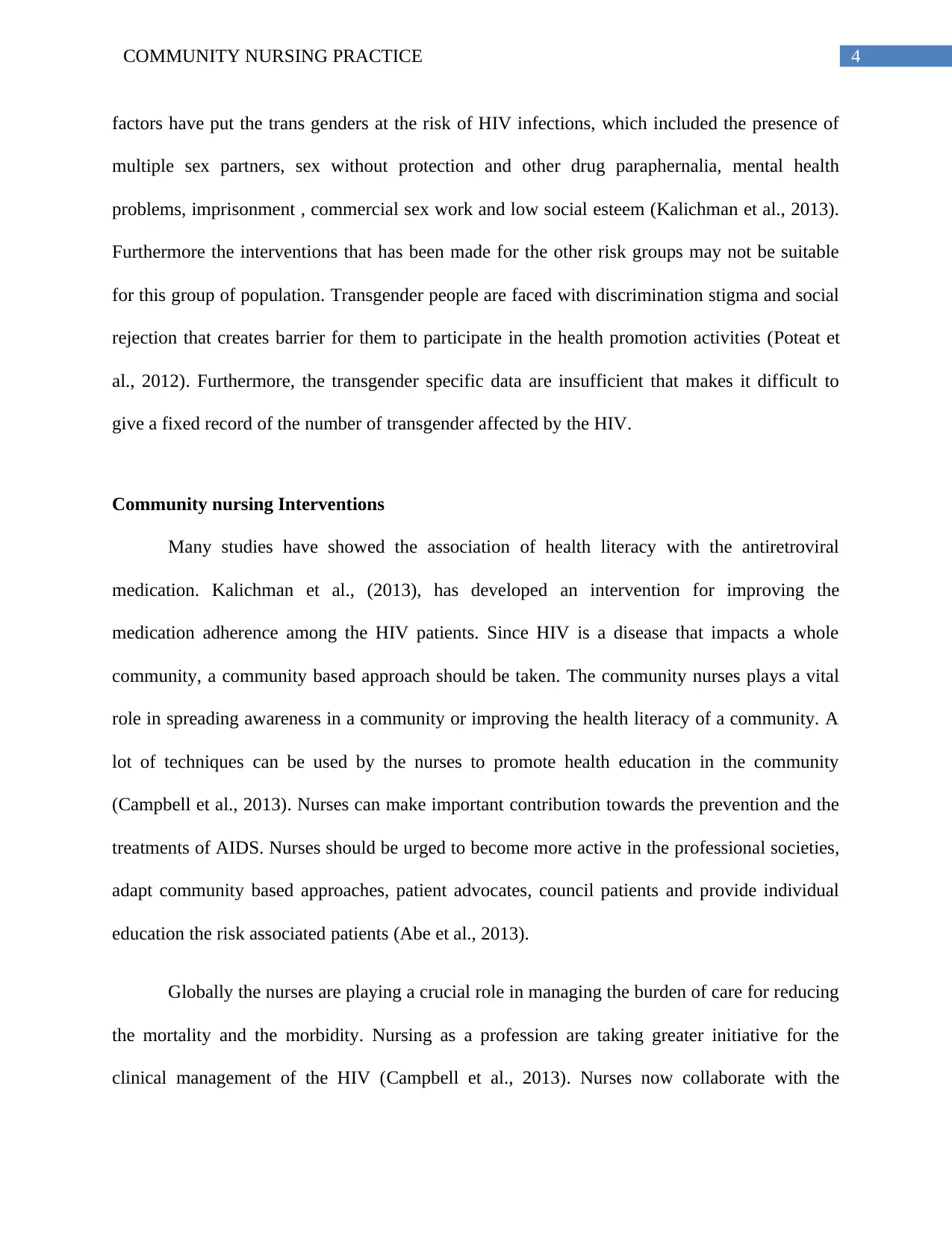
4COMMUNITY NURSING PRACTICE
factors have put the trans genders at the risk of HIV infections, which included the presence of
multiple sex partners, sex without protection and other drug paraphernalia, mental health
problems, imprisonment , commercial sex work and low social esteem (Kalichman et al., 2013).
Furthermore the interventions that has been made for the other risk groups may not be suitable
for this group of population. Transgender people are faced with discrimination stigma and social
rejection that creates barrier for them to participate in the health promotion activities (Poteat et
al., 2012). Furthermore, the transgender specific data are insufficient that makes it difficult to
give a fixed record of the number of transgender affected by the HIV.
Community nursing Interventions
Many studies have showed the association of health literacy with the antiretroviral
medication. Kalichman et al., (2013), has developed an intervention for improving the
medication adherence among the HIV patients. Since HIV is a disease that impacts a whole
community, a community based approach should be taken. The community nurses plays a vital
role in spreading awareness in a community or improving the health literacy of a community. A
lot of techniques can be used by the nurses to promote health education in the community
(Campbell et al., 2013). Nurses can make important contribution towards the prevention and the
treatments of AIDS. Nurses should be urged to become more active in the professional societies,
adapt community based approaches, patient advocates, council patients and provide individual
education the risk associated patients (Abe et al., 2013).
Globally the nurses are playing a crucial role in managing the burden of care for reducing
the mortality and the morbidity. Nursing as a profession are taking greater initiative for the
clinical management of the HIV (Campbell et al., 2013). Nurses now collaborate with the
factors have put the trans genders at the risk of HIV infections, which included the presence of
multiple sex partners, sex without protection and other drug paraphernalia, mental health
problems, imprisonment , commercial sex work and low social esteem (Kalichman et al., 2013).
Furthermore the interventions that has been made for the other risk groups may not be suitable
for this group of population. Transgender people are faced with discrimination stigma and social
rejection that creates barrier for them to participate in the health promotion activities (Poteat et
al., 2012). Furthermore, the transgender specific data are insufficient that makes it difficult to
give a fixed record of the number of transgender affected by the HIV.
Community nursing Interventions
Many studies have showed the association of health literacy with the antiretroviral
medication. Kalichman et al., (2013), has developed an intervention for improving the
medication adherence among the HIV patients. Since HIV is a disease that impacts a whole
community, a community based approach should be taken. The community nurses plays a vital
role in spreading awareness in a community or improving the health literacy of a community. A
lot of techniques can be used by the nurses to promote health education in the community
(Campbell et al., 2013). Nurses can make important contribution towards the prevention and the
treatments of AIDS. Nurses should be urged to become more active in the professional societies,
adapt community based approaches, patient advocates, council patients and provide individual
education the risk associated patients (Abe et al., 2013).
Globally the nurses are playing a crucial role in managing the burden of care for reducing
the mortality and the morbidity. Nursing as a profession are taking greater initiative for the
clinical management of the HIV (Campbell et al., 2013). Nurses now collaborate with the
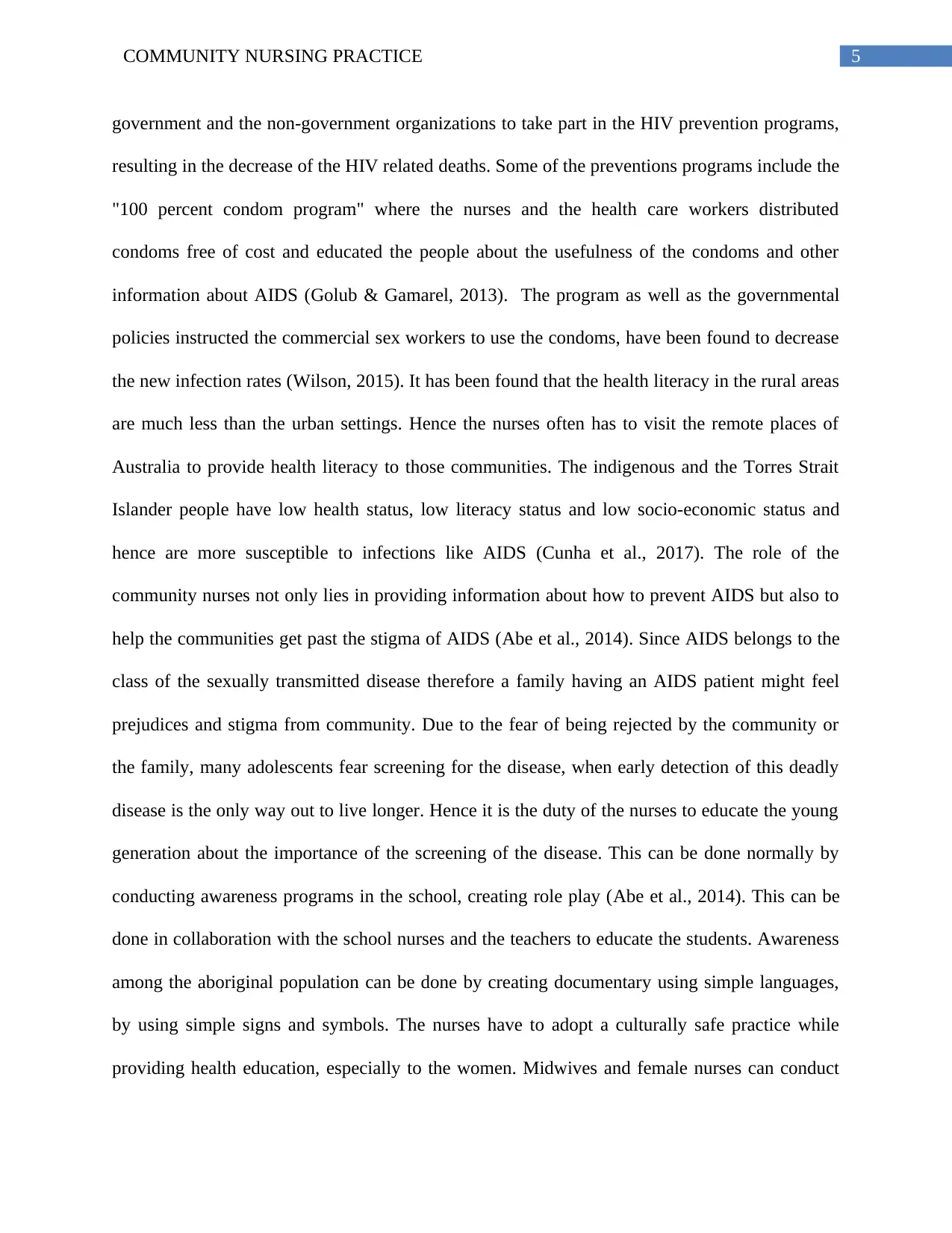
5COMMUNITY NURSING PRACTICE
government and the non-government organizations to take part in the HIV prevention programs,
resulting in the decrease of the HIV related deaths. Some of the preventions programs include the
"100 percent condom program" where the nurses and the health care workers distributed
condoms free of cost and educated the people about the usefulness of the condoms and other
information about AIDS (Golub & Gamarel, 2013). The program as well as the governmental
policies instructed the commercial sex workers to use the condoms, have been found to decrease
the new infection rates (Wilson, 2015). It has been found that the health literacy in the rural areas
are much less than the urban settings. Hence the nurses often has to visit the remote places of
Australia to provide health literacy to those communities. The indigenous and the Torres Strait
Islander people have low health status, low literacy status and low socio-economic status and
hence are more susceptible to infections like AIDS (Cunha et al., 2017). The role of the
community nurses not only lies in providing information about how to prevent AIDS but also to
help the communities get past the stigma of AIDS (Abe et al., 2014). Since AIDS belongs to the
class of the sexually transmitted disease therefore a family having an AIDS patient might feel
prejudices and stigma from community. Due to the fear of being rejected by the community or
the family, many adolescents fear screening for the disease, when early detection of this deadly
disease is the only way out to live longer. Hence it is the duty of the nurses to educate the young
generation about the importance of the screening of the disease. This can be done normally by
conducting awareness programs in the school, creating role play (Abe et al., 2014). This can be
done in collaboration with the school nurses and the teachers to educate the students. Awareness
among the aboriginal population can be done by creating documentary using simple languages,
by using simple signs and symbols. The nurses have to adopt a culturally safe practice while
providing health education, especially to the women. Midwives and female nurses can conduct
government and the non-government organizations to take part in the HIV prevention programs,
resulting in the decrease of the HIV related deaths. Some of the preventions programs include the
"100 percent condom program" where the nurses and the health care workers distributed
condoms free of cost and educated the people about the usefulness of the condoms and other
information about AIDS (Golub & Gamarel, 2013). The program as well as the governmental
policies instructed the commercial sex workers to use the condoms, have been found to decrease
the new infection rates (Wilson, 2015). It has been found that the health literacy in the rural areas
are much less than the urban settings. Hence the nurses often has to visit the remote places of
Australia to provide health literacy to those communities. The indigenous and the Torres Strait
Islander people have low health status, low literacy status and low socio-economic status and
hence are more susceptible to infections like AIDS (Cunha et al., 2017). The role of the
community nurses not only lies in providing information about how to prevent AIDS but also to
help the communities get past the stigma of AIDS (Abe et al., 2014). Since AIDS belongs to the
class of the sexually transmitted disease therefore a family having an AIDS patient might feel
prejudices and stigma from community. Due to the fear of being rejected by the community or
the family, many adolescents fear screening for the disease, when early detection of this deadly
disease is the only way out to live longer. Hence it is the duty of the nurses to educate the young
generation about the importance of the screening of the disease. This can be done normally by
conducting awareness programs in the school, creating role play (Abe et al., 2014). This can be
done in collaboration with the school nurses and the teachers to educate the students. Awareness
among the aboriginal population can be done by creating documentary using simple languages,
by using simple signs and symbols. The nurses have to adopt a culturally safe practice while
providing health education, especially to the women. Midwives and female nurses can conduct
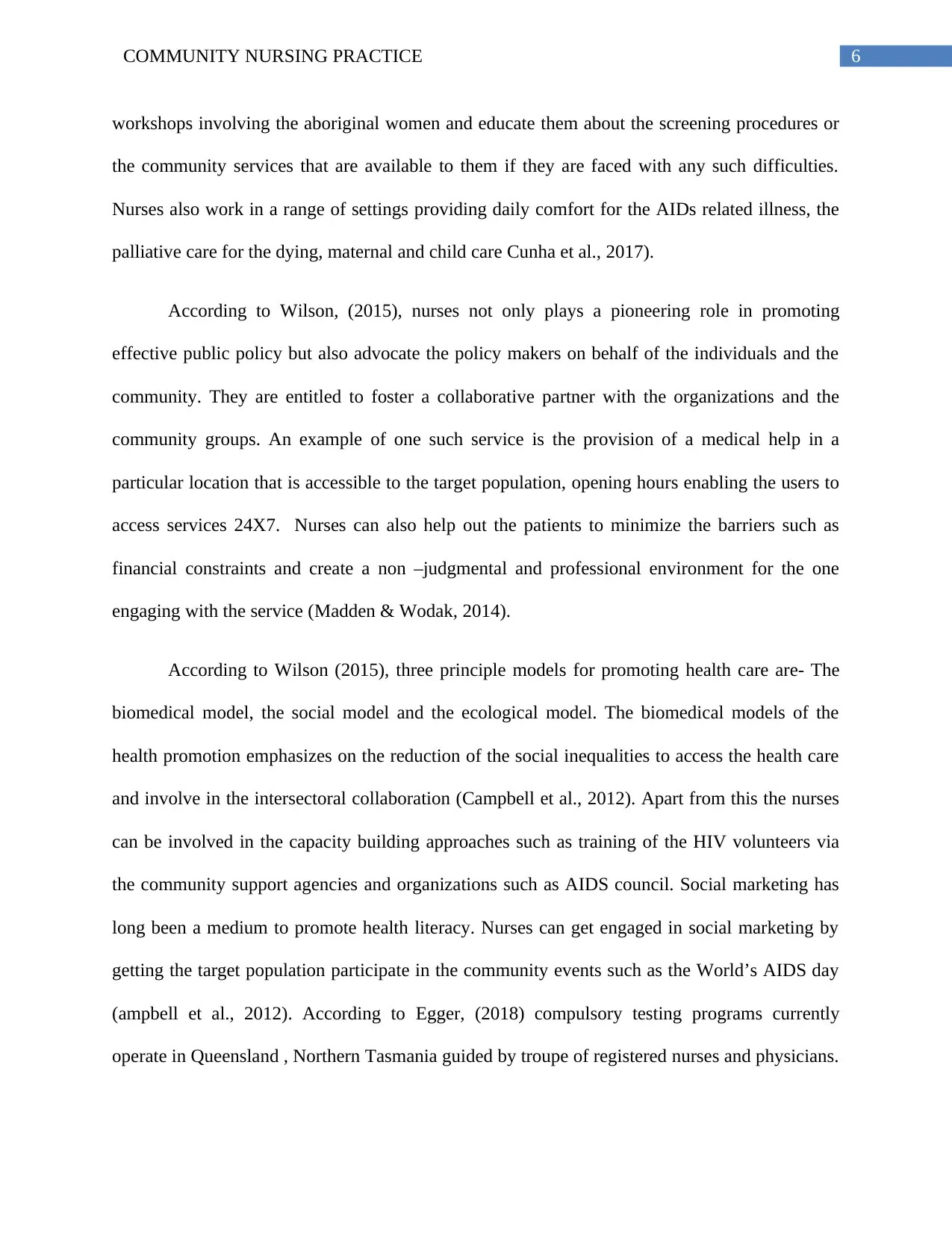
6COMMUNITY NURSING PRACTICE
workshops involving the aboriginal women and educate them about the screening procedures or
the community services that are available to them if they are faced with any such difficulties.
Nurses also work in a range of settings providing daily comfort for the AIDs related illness, the
palliative care for the dying, maternal and child care Cunha et al., 2017).
According to Wilson, (2015), nurses not only plays a pioneering role in promoting
effective public policy but also advocate the policy makers on behalf of the individuals and the
community. They are entitled to foster a collaborative partner with the organizations and the
community groups. An example of one such service is the provision of a medical help in a
particular location that is accessible to the target population, opening hours enabling the users to
access services 24X7. Nurses can also help out the patients to minimize the barriers such as
financial constraints and create a non –judgmental and professional environment for the one
engaging with the service (Madden & Wodak, 2014).
According to Wilson (2015), three principle models for promoting health care are- The
biomedical model, the social model and the ecological model. The biomedical models of the
health promotion emphasizes on the reduction of the social inequalities to access the health care
and involve in the intersectoral collaboration (Campbell et al., 2012). Apart from this the nurses
can be involved in the capacity building approaches such as training of the HIV volunteers via
the community support agencies and organizations such as AIDS council. Social marketing has
long been a medium to promote health literacy. Nurses can get engaged in social marketing by
getting the target population participate in the community events such as the World’s AIDS day
(ampbell et al., 2012). According to Egger, (2018) compulsory testing programs currently
operate in Queensland , Northern Tasmania guided by troupe of registered nurses and physicians.
workshops involving the aboriginal women and educate them about the screening procedures or
the community services that are available to them if they are faced with any such difficulties.
Nurses also work in a range of settings providing daily comfort for the AIDs related illness, the
palliative care for the dying, maternal and child care Cunha et al., 2017).
According to Wilson, (2015), nurses not only plays a pioneering role in promoting
effective public policy but also advocate the policy makers on behalf of the individuals and the
community. They are entitled to foster a collaborative partner with the organizations and the
community groups. An example of one such service is the provision of a medical help in a
particular location that is accessible to the target population, opening hours enabling the users to
access services 24X7. Nurses can also help out the patients to minimize the barriers such as
financial constraints and create a non –judgmental and professional environment for the one
engaging with the service (Madden & Wodak, 2014).
According to Wilson (2015), three principle models for promoting health care are- The
biomedical model, the social model and the ecological model. The biomedical models of the
health promotion emphasizes on the reduction of the social inequalities to access the health care
and involve in the intersectoral collaboration (Campbell et al., 2012). Apart from this the nurses
can be involved in the capacity building approaches such as training of the HIV volunteers via
the community support agencies and organizations such as AIDS council. Social marketing has
long been a medium to promote health literacy. Nurses can get engaged in social marketing by
getting the target population participate in the community events such as the World’s AIDS day
(ampbell et al., 2012). According to Egger, (2018) compulsory testing programs currently
operate in Queensland , Northern Tasmania guided by troupe of registered nurses and physicians.
Paraphrase This Document
Need a fresh take? Get an instant paraphrase of this document with our AI Paraphraser
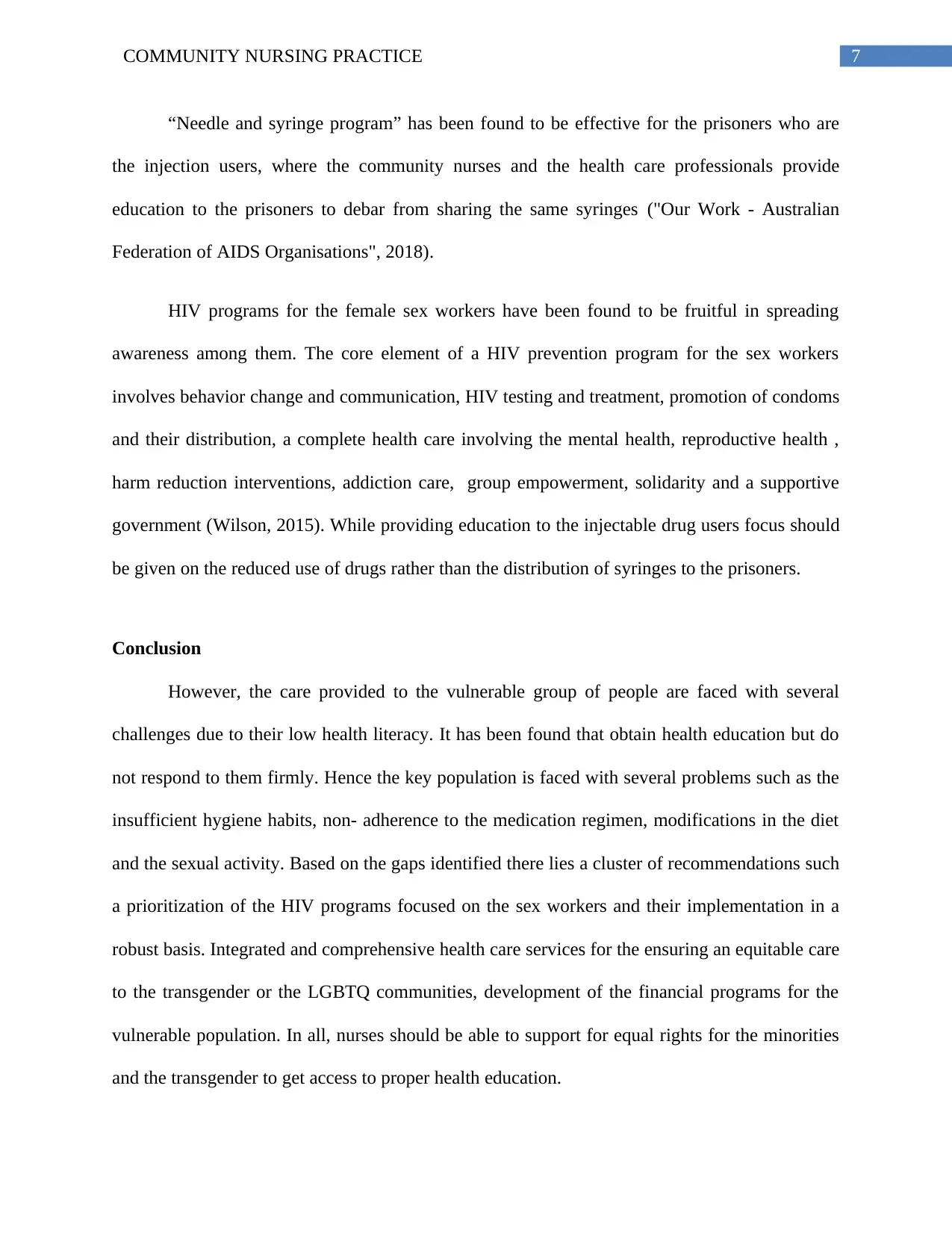
7COMMUNITY NURSING PRACTICE
“Needle and syringe program” has been found to be effective for the prisoners who are
the injection users, where the community nurses and the health care professionals provide
education to the prisoners to debar from sharing the same syringes ("Our Work - Australian
Federation of AIDS Organisations", 2018).
HIV programs for the female sex workers have been found to be fruitful in spreading
awareness among them. The core element of a HIV prevention program for the sex workers
involves behavior change and communication, HIV testing and treatment, promotion of condoms
and their distribution, a complete health care involving the mental health, reproductive health ,
harm reduction interventions, addiction care, group empowerment, solidarity and a supportive
government (Wilson, 2015). While providing education to the injectable drug users focus should
be given on the reduced use of drugs rather than the distribution of syringes to the prisoners.
Conclusion
However, the care provided to the vulnerable group of people are faced with several
challenges due to their low health literacy. It has been found that obtain health education but do
not respond to them firmly. Hence the key population is faced with several problems such as the
insufficient hygiene habits, non- adherence to the medication regimen, modifications in the diet
and the sexual activity. Based on the gaps identified there lies a cluster of recommendations such
a prioritization of the HIV programs focused on the sex workers and their implementation in a
robust basis. Integrated and comprehensive health care services for the ensuring an equitable care
to the transgender or the LGBTQ communities, development of the financial programs for the
vulnerable population. In all, nurses should be able to support for equal rights for the minorities
and the transgender to get access to proper health education.
“Needle and syringe program” has been found to be effective for the prisoners who are
the injection users, where the community nurses and the health care professionals provide
education to the prisoners to debar from sharing the same syringes ("Our Work - Australian
Federation of AIDS Organisations", 2018).
HIV programs for the female sex workers have been found to be fruitful in spreading
awareness among them. The core element of a HIV prevention program for the sex workers
involves behavior change and communication, HIV testing and treatment, promotion of condoms
and their distribution, a complete health care involving the mental health, reproductive health ,
harm reduction interventions, addiction care, group empowerment, solidarity and a supportive
government (Wilson, 2015). While providing education to the injectable drug users focus should
be given on the reduced use of drugs rather than the distribution of syringes to the prisoners.
Conclusion
However, the care provided to the vulnerable group of people are faced with several
challenges due to their low health literacy. It has been found that obtain health education but do
not respond to them firmly. Hence the key population is faced with several problems such as the
insufficient hygiene habits, non- adherence to the medication regimen, modifications in the diet
and the sexual activity. Based on the gaps identified there lies a cluster of recommendations such
a prioritization of the HIV programs focused on the sex workers and their implementation in a
robust basis. Integrated and comprehensive health care services for the ensuring an equitable care
to the transgender or the LGBTQ communities, development of the financial programs for the
vulnerable population. In all, nurses should be able to support for equal rights for the minorities
and the transgender to get access to proper health education.
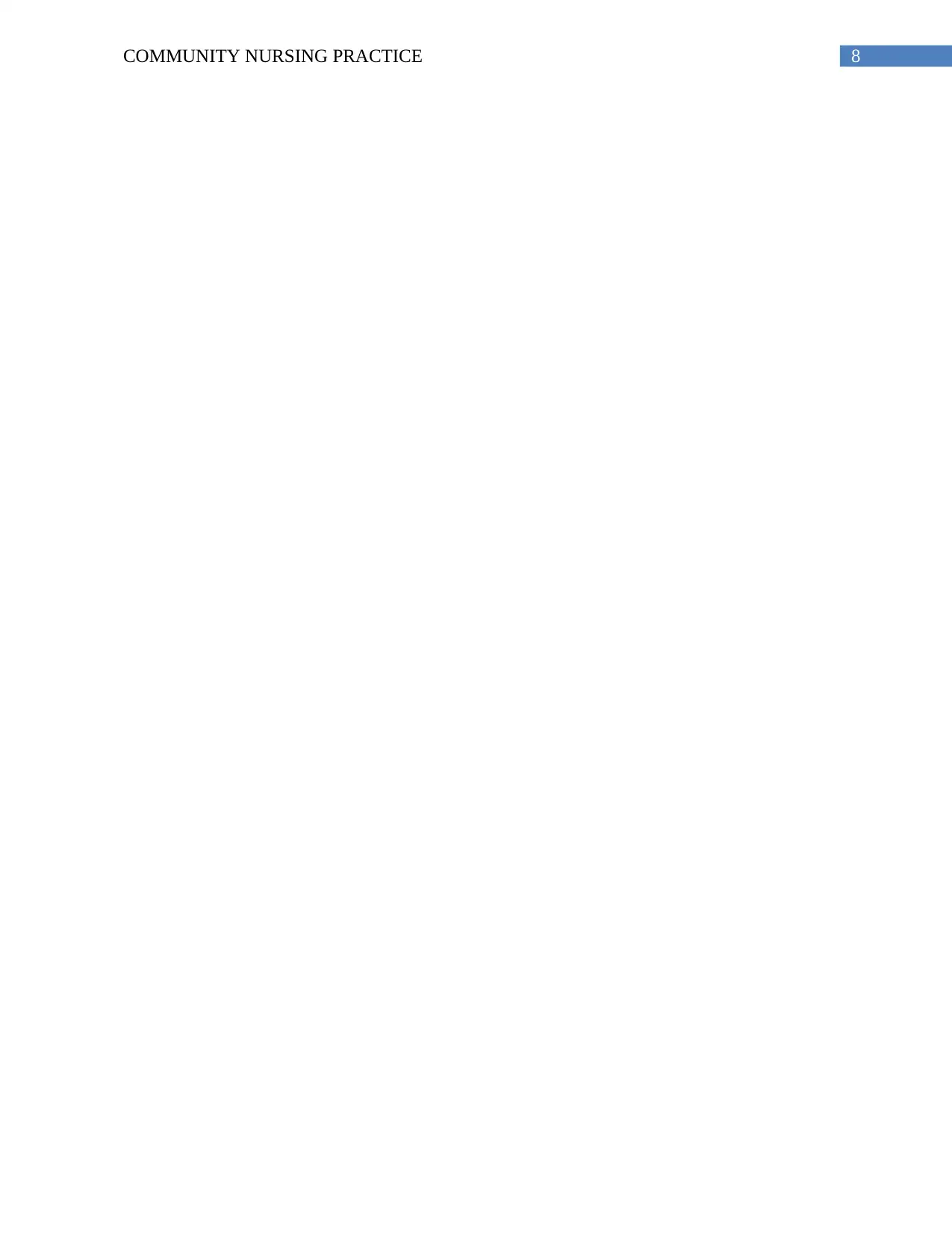
8COMMUNITY NURSING PRACTICE
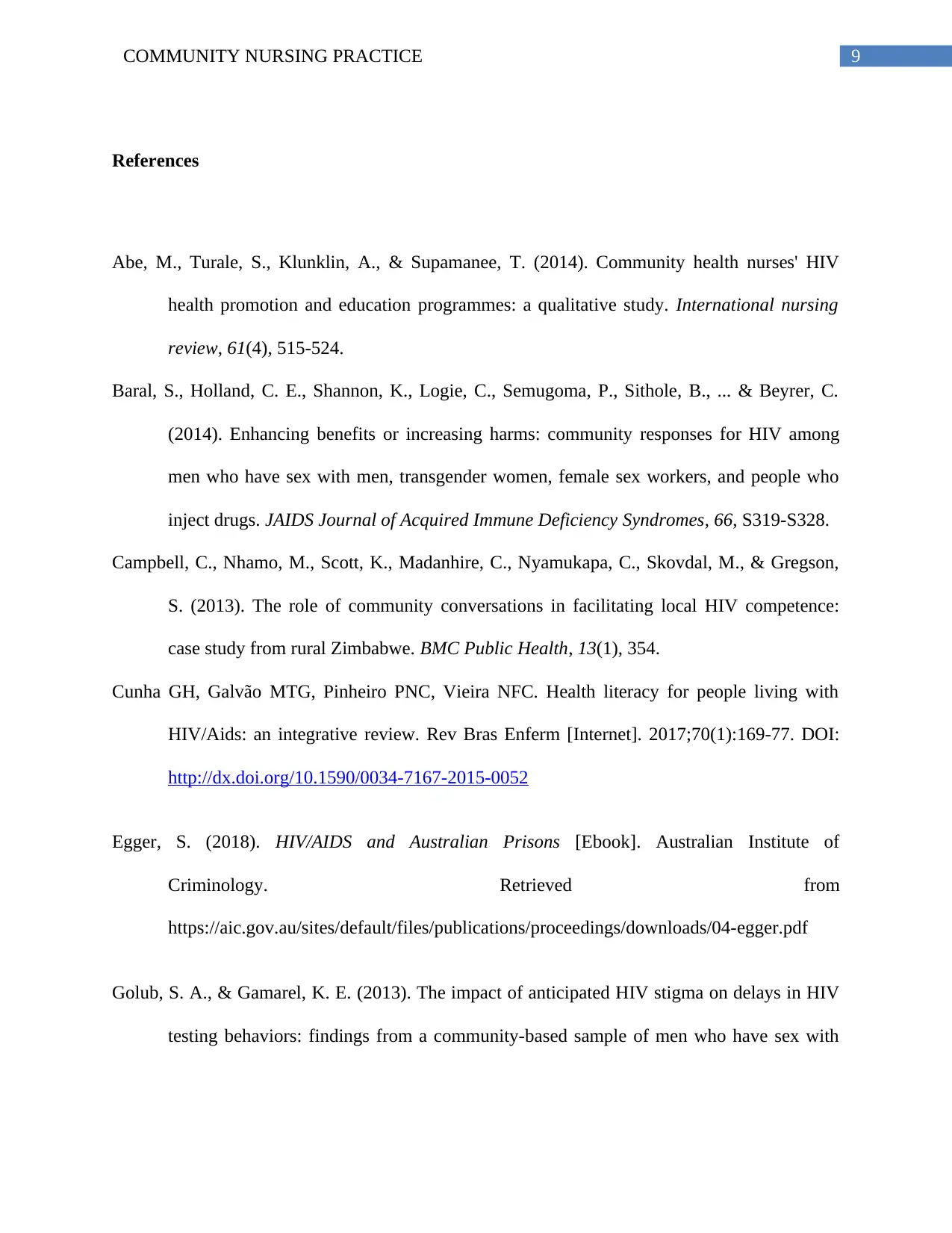
9COMMUNITY NURSING PRACTICE
References
Abe, M., Turale, S., Klunklin, A., & Supamanee, T. (2014). Community health nurses' HIV
health promotion and education programmes: a qualitative study. International nursing
review, 61(4), 515-524.
Baral, S., Holland, C. E., Shannon, K., Logie, C., Semugoma, P., Sithole, B., ... & Beyrer, C.
(2014). Enhancing benefits or increasing harms: community responses for HIV among
men who have sex with men, transgender women, female sex workers, and people who
inject drugs. JAIDS Journal of Acquired Immune Deficiency Syndromes, 66, S319-S328.
Campbell, C., Nhamo, M., Scott, K., Madanhire, C., Nyamukapa, C., Skovdal, M., & Gregson,
S. (2013). The role of community conversations in facilitating local HIV competence:
case study from rural Zimbabwe. BMC Public Health, 13(1), 354.
Cunha GH, Galvão MTG, Pinheiro PNC, Vieira NFC. Health literacy for people living with
HIV/Aids: an integrative review. Rev Bras Enferm [Internet]. 2017;70(1):169-77. DOI:
http://dx.doi.org/10.1590/0034-7167-2015-0052
Egger, S. (2018). HIV/AIDS and Australian Prisons [Ebook]. Australian Institute of
Criminology. Retrieved from
https://aic.gov.au/sites/default/files/publications/proceedings/downloads/04-egger.pdf
Golub, S. A., & Gamarel, K. E. (2013). The impact of anticipated HIV stigma on delays in HIV
testing behaviors: findings from a community-based sample of men who have sex with
References
Abe, M., Turale, S., Klunklin, A., & Supamanee, T. (2014). Community health nurses' HIV
health promotion and education programmes: a qualitative study. International nursing
review, 61(4), 515-524.
Baral, S., Holland, C. E., Shannon, K., Logie, C., Semugoma, P., Sithole, B., ... & Beyrer, C.
(2014). Enhancing benefits or increasing harms: community responses for HIV among
men who have sex with men, transgender women, female sex workers, and people who
inject drugs. JAIDS Journal of Acquired Immune Deficiency Syndromes, 66, S319-S328.
Campbell, C., Nhamo, M., Scott, K., Madanhire, C., Nyamukapa, C., Skovdal, M., & Gregson,
S. (2013). The role of community conversations in facilitating local HIV competence:
case study from rural Zimbabwe. BMC Public Health, 13(1), 354.
Cunha GH, Galvão MTG, Pinheiro PNC, Vieira NFC. Health literacy for people living with
HIV/Aids: an integrative review. Rev Bras Enferm [Internet]. 2017;70(1):169-77. DOI:
http://dx.doi.org/10.1590/0034-7167-2015-0052
Egger, S. (2018). HIV/AIDS and Australian Prisons [Ebook]. Australian Institute of
Criminology. Retrieved from
https://aic.gov.au/sites/default/files/publications/proceedings/downloads/04-egger.pdf
Golub, S. A., & Gamarel, K. E. (2013). The impact of anticipated HIV stigma on delays in HIV
testing behaviors: findings from a community-based sample of men who have sex with
Secure Best Marks with AI Grader
Need help grading? Try our AI Grader for instant feedback on your assignments.
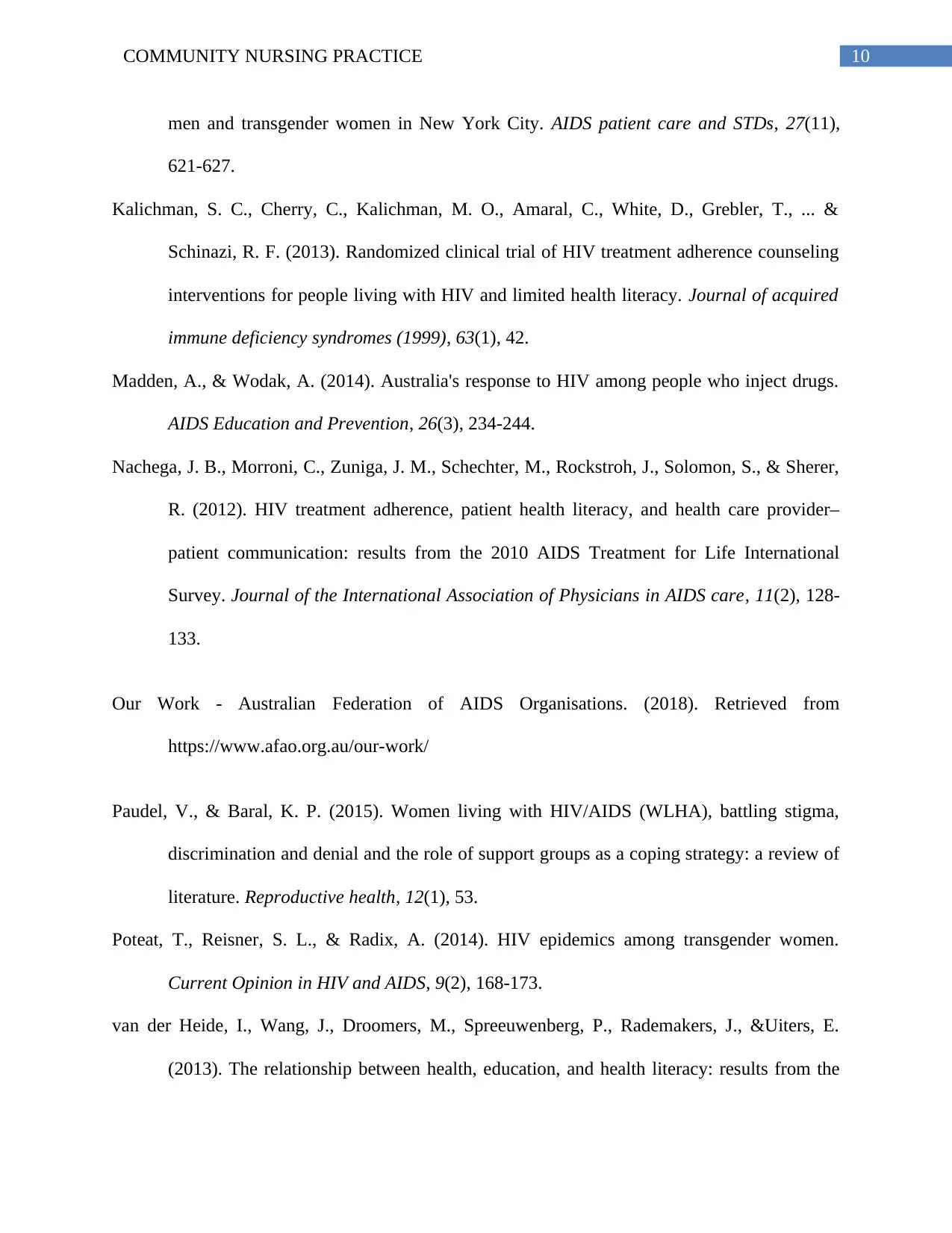
10COMMUNITY NURSING PRACTICE
men and transgender women in New York City. AIDS patient care and STDs, 27(11),
621-627.
Kalichman, S. C., Cherry, C., Kalichman, M. O., Amaral, C., White, D., Grebler, T., ... &
Schinazi, R. F. (2013). Randomized clinical trial of HIV treatment adherence counseling
interventions for people living with HIV and limited health literacy. Journal of acquired
immune deficiency syndromes (1999), 63(1), 42.
Madden, A., & Wodak, A. (2014). Australia's response to HIV among people who inject drugs.
AIDS Education and Prevention, 26(3), 234-244.
Nachega, J. B., Morroni, C., Zuniga, J. M., Schechter, M., Rockstroh, J., Solomon, S., & Sherer,
R. (2012). HIV treatment adherence, patient health literacy, and health care provider–
patient communication: results from the 2010 AIDS Treatment for Life International
Survey. Journal of the International Association of Physicians in AIDS care, 11(2), 128-
133.
Our Work - Australian Federation of AIDS Organisations. (2018). Retrieved from
https://www.afao.org.au/our-work/
Paudel, V., & Baral, K. P. (2015). Women living with HIV/AIDS (WLHA), battling stigma,
discrimination and denial and the role of support groups as a coping strategy: a review of
literature. Reproductive health, 12(1), 53.
Poteat, T., Reisner, S. L., & Radix, A. (2014). HIV epidemics among transgender women.
Current Opinion in HIV and AIDS, 9(2), 168-173.
van der Heide, I., Wang, J., Droomers, M., Spreeuwenberg, P., Rademakers, J., &Uiters, E.
(2013). The relationship between health, education, and health literacy: results from the
men and transgender women in New York City. AIDS patient care and STDs, 27(11),
621-627.
Kalichman, S. C., Cherry, C., Kalichman, M. O., Amaral, C., White, D., Grebler, T., ... &
Schinazi, R. F. (2013). Randomized clinical trial of HIV treatment adherence counseling
interventions for people living with HIV and limited health literacy. Journal of acquired
immune deficiency syndromes (1999), 63(1), 42.
Madden, A., & Wodak, A. (2014). Australia's response to HIV among people who inject drugs.
AIDS Education and Prevention, 26(3), 234-244.
Nachega, J. B., Morroni, C., Zuniga, J. M., Schechter, M., Rockstroh, J., Solomon, S., & Sherer,
R. (2012). HIV treatment adherence, patient health literacy, and health care provider–
patient communication: results from the 2010 AIDS Treatment for Life International
Survey. Journal of the International Association of Physicians in AIDS care, 11(2), 128-
133.
Our Work - Australian Federation of AIDS Organisations. (2018). Retrieved from
https://www.afao.org.au/our-work/
Paudel, V., & Baral, K. P. (2015). Women living with HIV/AIDS (WLHA), battling stigma,
discrimination and denial and the role of support groups as a coping strategy: a review of
literature. Reproductive health, 12(1), 53.
Poteat, T., Reisner, S. L., & Radix, A. (2014). HIV epidemics among transgender women.
Current Opinion in HIV and AIDS, 9(2), 168-173.
van der Heide, I., Wang, J., Droomers, M., Spreeuwenberg, P., Rademakers, J., &Uiters, E.
(2013). The relationship between health, education, and health literacy: results from the
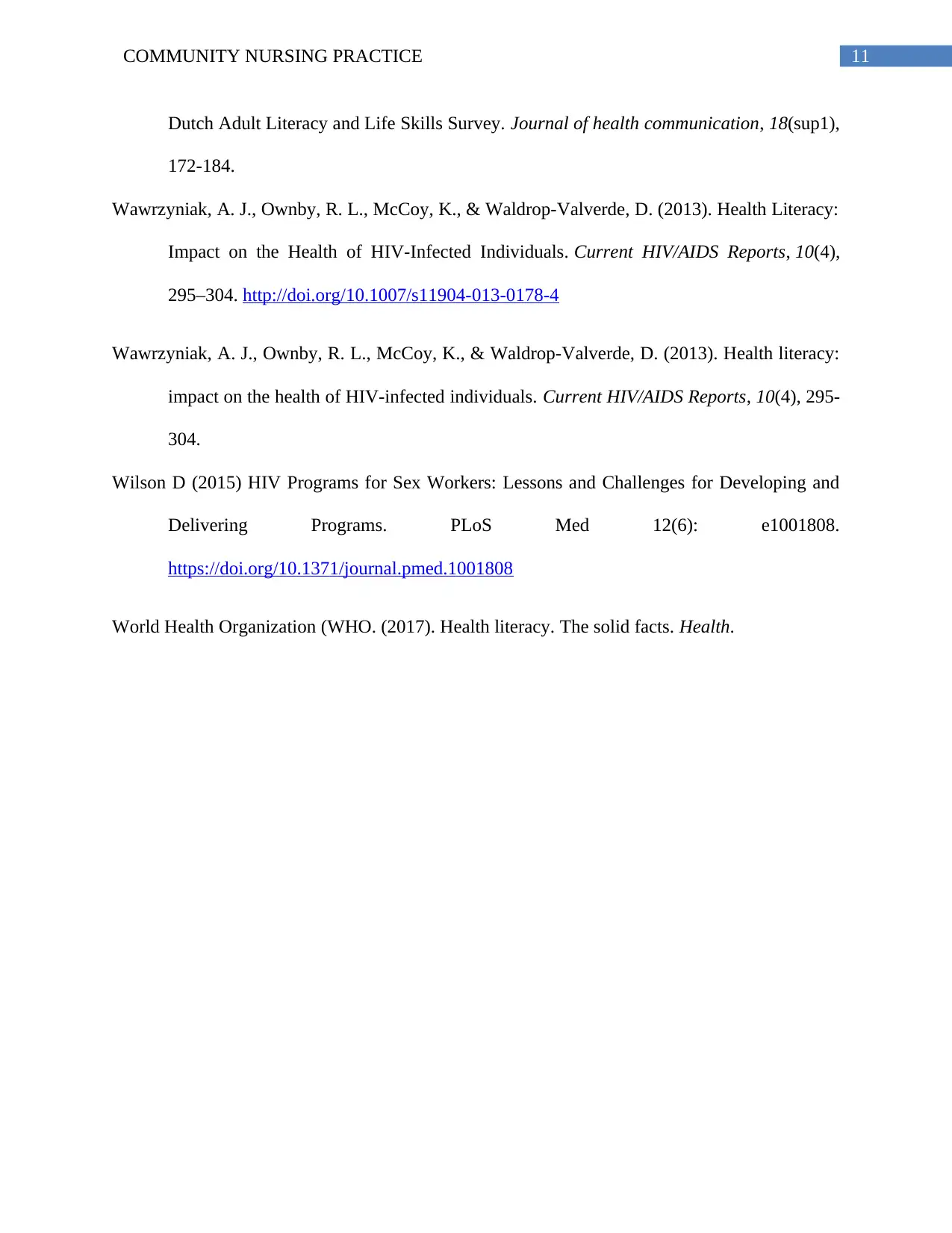
11COMMUNITY NURSING PRACTICE
Dutch Adult Literacy and Life Skills Survey. Journal of health communication, 18(sup1),
172-184.
Wawrzyniak, A. J., Ownby, R. L., McCoy, K., & Waldrop-Valverde, D. (2013). Health Literacy:
Impact on the Health of HIV-Infected Individuals. Current HIV/AIDS Reports, 10(4),
295–304. http://doi.org/10.1007/s11904-013-0178-4
Wawrzyniak, A. J., Ownby, R. L., McCoy, K., & Waldrop-Valverde, D. (2013). Health literacy:
impact on the health of HIV-infected individuals. Current HIV/AIDS Reports, 10(4), 295-
304.
Wilson D (2015) HIV Programs for Sex Workers: Lessons and Challenges for Developing and
Delivering Programs. PLoS Med 12(6): e1001808.
https://doi.org/10.1371/journal.pmed.1001808
World Health Organization (WHO. (2017). Health literacy. The solid facts. Health.
Dutch Adult Literacy and Life Skills Survey. Journal of health communication, 18(sup1),
172-184.
Wawrzyniak, A. J., Ownby, R. L., McCoy, K., & Waldrop-Valverde, D. (2013). Health Literacy:
Impact on the Health of HIV-Infected Individuals. Current HIV/AIDS Reports, 10(4),
295–304. http://doi.org/10.1007/s11904-013-0178-4
Wawrzyniak, A. J., Ownby, R. L., McCoy, K., & Waldrop-Valverde, D. (2013). Health literacy:
impact on the health of HIV-infected individuals. Current HIV/AIDS Reports, 10(4), 295-
304.
Wilson D (2015) HIV Programs for Sex Workers: Lessons and Challenges for Developing and
Delivering Programs. PLoS Med 12(6): e1001808.
https://doi.org/10.1371/journal.pmed.1001808
World Health Organization (WHO. (2017). Health literacy. The solid facts. Health.
1 out of 12
Related Documents
Your All-in-One AI-Powered Toolkit for Academic Success.
+13062052269
info@desklib.com
Available 24*7 on WhatsApp / Email
![[object Object]](/_next/static/media/star-bottom.7253800d.svg)
Unlock your academic potential
© 2024 | Zucol Services PVT LTD | All rights reserved.





